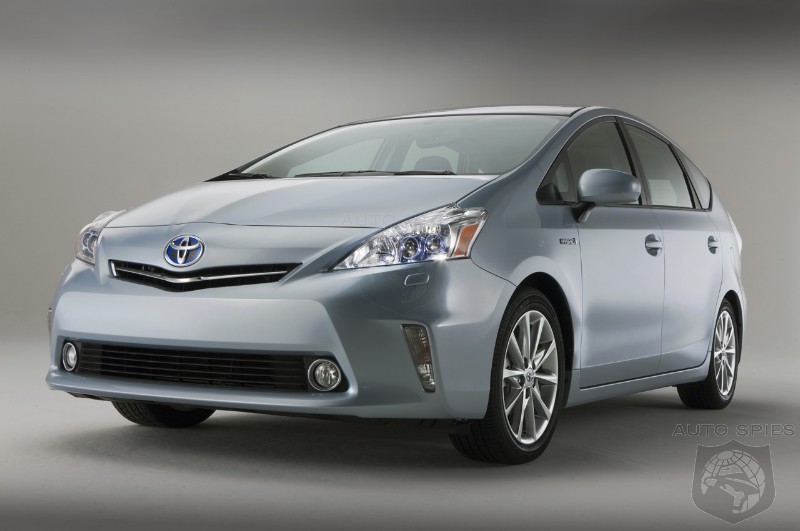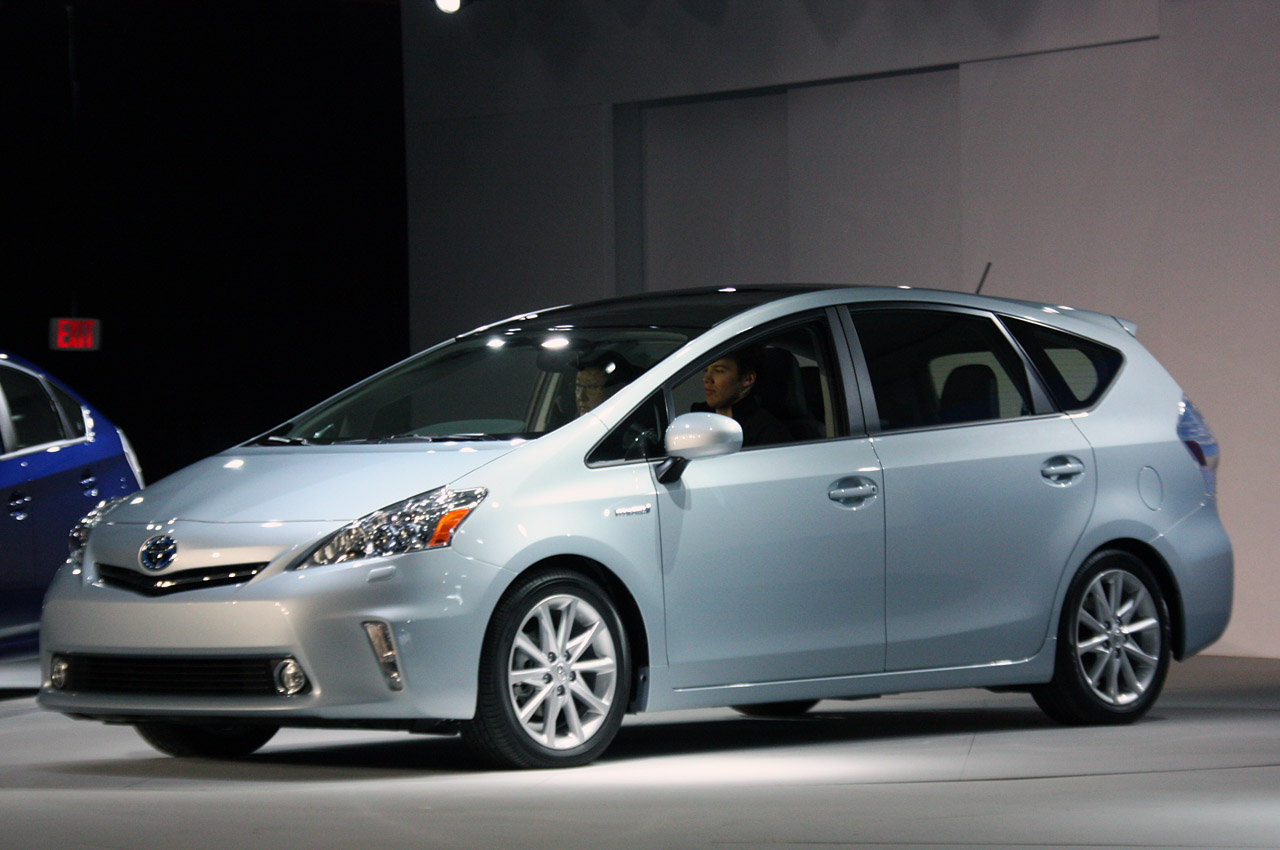The Prius v styling looks like a European-style small minivan and has a 0.29 drag coefficient with a shape that evolved from the Prius. The exterior styling is rounded with an extended roofline that allows the vehicle to retain the triangular silhouette symbolic of Prius. Other differences are the trapezoidal-shaped front with sharp-edged headlamps and wind-slipping aero corners for improved aerodynamics, as well as an enlarged under grille. The rear styling has a specially designed roof spoiler that improves air flow.

2012 Toyota Prius V Front

2012 toyota prius v 2012
The interior cargo space is more than 50% larger than the 2010 Toyota Prius, 5 inches (130 mm) longer and 1 inch (25 mm) wider, providing 34.3 cubic feet (970 L) of cargo space behind the rear seats; it also offers 38 inches (970 mm) of rear leg room, and more head height.

2012 Toyota Prius V still on
The Toyota Prius v includes many of the same standard features of the 2010 Prius, with four driving modes: Normal, Power, Eco and EV; smart key with push button start, an electronic shift lever, Hill Start Assist Control (HAC), and a back-up camera. Available options include energy-efficient LED headlamps, dynamic radar cruise control with a Pre-Collision System (PCS), and advanced parking guidance system. The Prius v has several technical advancements including Toyota's new Toyota Entune Multimedia System and a panoramic sunroof made of lightweight-resin, 40% lighter than a glass roof of the same size. Entune will premiere on the 2012 Toyota Prius v.

2012 Toyota Prius V Photo
The Prius v powertrain uses the same 1.8 liter Atkinson cycle gasoline inline-four engine used in the conventional Prius, a 60KWh traction motor, and shares the Prius's Hybrid Synergy Drive system and the same 201Vnickel-metal hydride battery pack.

last 2012 Toyota Prius v

2012 Toyota Prius V Cargo Room
Toyota introduced some refinements unique to the Prius v powertrain. These refinements include a new "Pitch and Bounce" motor control that the Prius v automatically employs on undulating roads and the refined control was designed to improve ride comfort and control. Because the Prius v is a larger vehicle with greater load capacity, suspension components were redesigned to improve handling and ride quality. "Pitch and Bounce" control works with the vehicle's suspension to cancel longitudinal oscillation when the Prius v is driven over uneven surfaces.

2012 Toyota,Prius ,Toyota

2012 Toyota Prius Plug In

2012 Toyota Prius V MPV
The Prius v also includes a redesigned engine coolant heating structure surrounding the vehicle's catalytic converter and the exhaust heat recirculation system has been refined to reduce engine warm-up time and improve occupant heater response time in cold weather. A switch valve electronically controls coolant recirculation through the exhaust heat recirculation system.

2012 toyota prius v front side

2012 Toyota Prius V Side View
In the United States the 2012 model year Prius v includes Toyota's Vehicle Proximity Notification System (VPNS), which is designed to alert pedestrians, the blind, and others of the vehicle's presence due to significant noise reduction typical of a hybrid vehicle traveling at low speeds in EV mode. This type of warning device is mandated by the Pedestrian Safety Enhancement Act of 2010. The warning sound is generated by externally mounted speakers and it activates automatically only at speeds below about 15 mph (24 km/h). The pitch varies with the vehicle's speed to give pedestrians a sense of whether the approaching Prius is accelerating or decelerating.

2012 Toyota Prius V Rear Seats

2012 Toyota Prius V

2012 Toyota Prius V – Interior

2012 Toyota Prius v -- 2011

2012 Toyota Prius V

2012 Toyota Prius V Front

2012 toyota prius v 2012
The interior cargo space is more than 50% larger than the 2010 Toyota Prius, 5 inches (130 mm) longer and 1 inch (25 mm) wider, providing 34.3 cubic feet (970 L) of cargo space behind the rear seats; it also offers 38 inches (970 mm) of rear leg room, and more head height.

2012 Toyota Prius V still on
The Toyota Prius v includes many of the same standard features of the 2010 Prius, with four driving modes: Normal, Power, Eco and EV; smart key with push button start, an electronic shift lever, Hill Start Assist Control (HAC), and a back-up camera. Available options include energy-efficient LED headlamps, dynamic radar cruise control with a Pre-Collision System (PCS), and advanced parking guidance system. The Prius v has several technical advancements including Toyota's new Toyota Entune Multimedia System and a panoramic sunroof made of lightweight-resin, 40% lighter than a glass roof of the same size. Entune will premiere on the 2012 Toyota Prius v.

2012 Toyota Prius V Photo
The Prius v powertrain uses the same 1.8 liter Atkinson cycle gasoline inline-four engine used in the conventional Prius, a 60KWh traction motor, and shares the Prius's Hybrid Synergy Drive system and the same 201Vnickel-metal hydride battery pack.

last 2012 Toyota Prius v

2012 Toyota Prius V Cargo Room
Toyota introduced some refinements unique to the Prius v powertrain. These refinements include a new "Pitch and Bounce" motor control that the Prius v automatically employs on undulating roads and the refined control was designed to improve ride comfort and control. Because the Prius v is a larger vehicle with greater load capacity, suspension components were redesigned to improve handling and ride quality. "Pitch and Bounce" control works with the vehicle's suspension to cancel longitudinal oscillation when the Prius v is driven over uneven surfaces.

2012 Toyota,Prius ,Toyota

2012 Toyota Prius Plug In

2012 Toyota Prius V MPV
The Prius v also includes a redesigned engine coolant heating structure surrounding the vehicle's catalytic converter and the exhaust heat recirculation system has been refined to reduce engine warm-up time and improve occupant heater response time in cold weather. A switch valve electronically controls coolant recirculation through the exhaust heat recirculation system.

2012 toyota prius v front side

2012 Toyota Prius V Side View
In the United States the 2012 model year Prius v includes Toyota's Vehicle Proximity Notification System (VPNS), which is designed to alert pedestrians, the blind, and others of the vehicle's presence due to significant noise reduction typical of a hybrid vehicle traveling at low speeds in EV mode. This type of warning device is mandated by the Pedestrian Safety Enhancement Act of 2010. The warning sound is generated by externally mounted speakers and it activates automatically only at speeds below about 15 mph (24 km/h). The pitch varies with the vehicle's speed to give pedestrians a sense of whether the approaching Prius is accelerating or decelerating.

2012 Toyota Prius V Rear Seats

2012 Toyota Prius V

2012 Toyota Prius V – Interior

2012 Toyota Prius v -- 2011

2012 Toyota Prius V
No comments:
Post a Comment